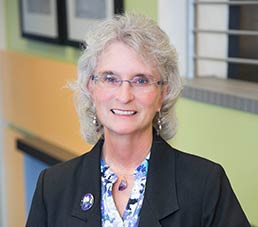Social Work Spotlight: Medical Child Abuse
Suzanne M. Schunk, LCSW, ACSW, is the vice president of Family Support Services at Southwest Human Development. In her 40 years’ experience of dedicating her life to helping children and their families – nearly 20 years with medical child abuse cases – Suzanne has worked with families in which parents or caregivers have been accused of child abuse and/or neglect.

Recently named a “National Expert in Medical Child Abuse,” we sat down with Suzanne to talk about her extensive early childhood development expertise and the impact of medical child abuse.
Everybody knows that the first five years of a child’s life are most critical for early childhood development, but what’s one thing that’s not being talked about should be?
Not every child has the gift of a quality home environment with nurturing, loving parents. There are some parents who, to meet their own emotional needs, take advantage of children medically. This type of abuse is known as medical child abuse (or Munchausen syndrome by proxy, pediatric illness falsification and/or factitious disorder imposed on another) and largely consists of mothers who knowingly make false claims that their child suffers from various medical diagnoses.
Parents who commit medical child abuse use deception and pressure doctors to give children unnecessary medical tests, medications, surgeries and so forth. It’s critical to know that this is a subset of child abuse and is different than medical neglect, in which parents and caregivers are unable or unwilling to provide their child with the adequate medical, emotional or dental care they need to be healthy.
What impact does medical child abuse have on children?
Unnecessary tests and procedures cause great damage to a child’s physical and emotional wellbeing, as well as their identity. These children are often isolated because of all the medical appointments and hospitalizations, causing them to fall behind socially and academically. The numerous medical procedures cause pain and can have serious side effects, as can unnecessary medications. Many times these children believe they are dying and their self-perception is that they are very ill.
As children who suffer from medical child abuse get older, they develop challenges coping and understanding what a safe environment is like after being abused. This is a highly-traumatic issue for children that can have very serious long-term consequences and can even be fatal.
Why is it so difficult to identify medical child abuse?
Due to the assumption that every parent or caregiver takes their children to a medical professional with good intentions, medical child abuse often goes unrecognized. One of the most challenging characteristics of parents and caregivers who commit medical child abuse is that they are extremely adept at lying and consistently use deception to achieve their goals.
Doctors are taught to believe parents and to listen to symptoms while providing care and comfort. When a parent says, “My child is throwing up all the time,” or “My child may need a feeding tube because they can’t tolerate any solid foods,” the doctor is more likely to believe that parent than to think those claims could possibly be made up. Abusers often conduct extensive research in order to know exactly which symptoms to describe to the doctor. If parents or caregivers request a specific medical test and the results show that the child is healthy, the parent will typically argue or visit a different doctor – sometimes even fabricating medical records to alter results that a new doctor sees.
 How common is medical child abuse?
How common is medical child abuse?
The number of medical child abuse cases is unknown because it’s so difficult to detect and many people aren’t aware of it. Far too few medical and caregiving professionals are educated on how to identify medical child abuse. Southwest Human Development staff, the Arizona Department of Child Safety and various local hospitals and medical staff have become more knowledgeable about medical child abuse in recent years. This past year, the number of cases that have been specifically identified has risen from just one or two a year to 13 – a number unheard of across the country. Many practitioners may only see one or two cases in their lifetime, if any, solely because they don’t know the symptoms so they cannot identify possible cases.
What are we doing here in Arizona to address this problem?
I’ve worked over the years with experts on the local, state and national levels, and partnered with the Arizona Department of Child Safety to develop a state-wide medical child abuse program of intervention that has been determined to be the model program for this issue across the country. Child welfare investigation protocol, therapeutic supervised visitation, multidisciplinary teams, case management protocol and permanency planning are key components of the newly-created program in Arizona.
A main challenge we faced is the vast size of Arizona, but we are seeing results particularly here in Maricopa County. Implementing similar programs across the U.S. could be a very daunting process. Another challenge is providing quality medical child abuse training and education that is required for all Arizona Department of Child Safety staff and court judges. It’s a constant struggle to maintain ongoing education and because it is also known by a variety of other names, many professionals are confused about it.
What types of shifts or trends have you seen in this area?
I’ve observed an increased awareness in the professional community as more national conferences are highlighting this issue. Media and even the public have begun to take notice. We at Southwest Human Development use the term medical child abuse simply because it’s more comprehensive and easier to understand. The simplicity of this term has helped people better understand this behavior as a form of child abuse. While a growing number of professionals in various fields are learning more, it’s important that as we move forward we are able to educate schools, lawyers, therapists, early interventionists and a wide range of processionals to increase the impact of identifying potential cases. Although there’s progress in raising awareness for this issue, we have a long way to go.
Looking out 3 to 5 years, what do you think the future holds when it comes to medical child abuse?
I anticipate that in the next few years the national model developed here in Arizona on how to respond to these cases will be far more readily available and well-known. As the medical community is becoming increasingly more aware of medical child abuse, the number of educated professionals in the field will also grow. It’s my hope that through significant educational opportunities, more cases will be identified to start the intervention process and begin a journey to a better future for children throughout the nation.
All content in this article, including any advice or commentary from Southwest Human Development staff and/or others, should be considered an opinion and is provided for informational purposes only. The content is not intended to be a substitute for medical or other professional advice, diagnosis or treatment. Always seek the direct advice of your own trusted professional with any questions or concerns you may have regarding the child/ren in your care. Southwest Human Development does not recommend or endorse any specific tests, products, procedures or other information that may be mentioned in this article. You may contact Southwest Human Development’s Birth to Five Helpline at 1-877-705-KIDS (5437) to speak with one of our early childhood professionals for personalized assistance. Birth to Five Helpline specialists are available Monday through Friday from 8 a.m. to 8 p.m.
